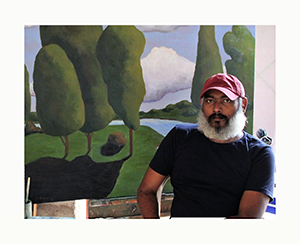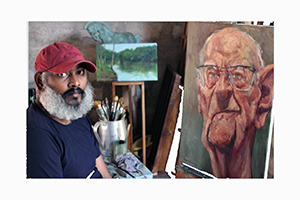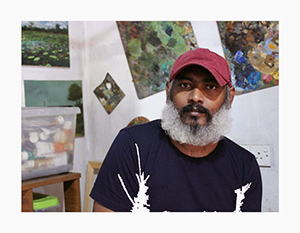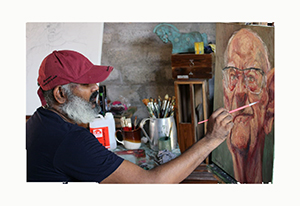Caricature art is now gaining popularity across the world. Today we are prepared to speak with a cartoonist and illustrator from Sri Lanka today. He is none other than Inaje Dilshan Fernando, who's work is inspired by the art of impressionism. A world beater in his chosen field, he is here to give his views to you.
How
long have you been painting?
I have been painting since I was child but professionally I started art only in 2004 after I started studying art as a subject. However I did a lot of self study and used to observe how natural objects behaved and their lines and shapes. This was my start in a nutshell.
 Who
are your greatest influencers?
Who
are your greatest influencers?
My father has always been my mentor and figure behind me and my career. He was attached to a government career involving fishing and fisheries which initially gave me the inspiration to create nature work and seascapes which I further developed later. Further, my family is pretty art oriented, which was also very helpful.
Did
you have a formal education in art and painting or are you self-taught?
Although I started as self taught artist, I later decided to polish my skills by obtaining a formal education in art and in 2004 I started my academic career at Vibhavi Art Academy under the famous Sri Lankan creator Chandraguptha Thenuwara. I continued to study there until I graduated in 2010 with loads of knowledge and experience behind me.
Do you have a particular style? How did you become so passionate about this particular style?
I don't mean to limit myself to one style when I mention
"style." However I do favor abstract and semi-abstract styles and my strong style is considered to be cartoons and caricature art where I have won many awards locally and internationally. With caricature art, I am able to express myself where each and every painting speaks a clear message which the audience can decipher.
 What
are your other passions other than art? How have these passions contributed you
to becoming the artist you are today?
What
are your other passions other than art? How have these passions contributed you
to becoming the artist you are today?
Although there is no directly associated with my career, my biggest passion is collecting antiques. Most of the antiques I have in my collection is related to the fishing industry in Sri Lanka where I got the inspiration to become an artist as a child. Collecting old and unique items gives me lots of pleasure and its clearly a positive influence for my work as well.
Could
you walk us through your process? Percentage-wise, how much time do you spend
preparing for the painting and how much time on the actual painting itself? Is
preparation an important part of your process?
Definitely. It is quite hard for me to pre-determine the time I need to spend creating a painting as each creation is unique and has different levels of complexity depending on a subject, materials used etc. The process time also differs depending on my personal mood. When I'm in my creative self, the creative process flows smoothly and effortless. I usually study the subject beforehand and have a visual of the final product in my mind. Then its a matter of completing the painting and get it as close to my visual product as possible. Its a process which I've developed over the years and its gets easier with experience.
 Are
you engaged in new artistic adventures? How is artistic exploration important
to you as an artist and to your process? How do you then decide what to
incorporate into your style and what to leave as pure fun?
Are
you engaged in new artistic adventures? How is artistic exploration important
to you as an artist and to your process? How do you then decide what to
incorporate into your style and what to leave as pure fun?
I am an artist who like to express myself through my art and the recent events in Sri Lanka gave me an opportunity to express myself and give a voice to the voiceless through my art. In support of this, I launched a series of caricatures which was well received by most of my audience. Its a quite a serious turn of events with lots of negativity being promoted and I hope my creations were able to somewhat change these negative thoughts and bring some light into people's lives.
Was
there a particular moment where you could tell that your skills had just
crossed over into being an exceptionally good painter instead of a pretty good
painter? What did you do to make that leap?
My turning point is when I decided to venture into becoming a caricature artist from being a conventional painter. This area has brought me so many opportunities and made me a household name in caricature art locally and internationally. I did not know that I had this skill in me until I completely transformed myself in 2017 which was quite a pleasant experience.
I had the honor of meeting a true great in caricature art in person while being on a professional trip in Dubai, UAE which was the true turning point for me. What started as an experiment for me has evolved into a true commercial enterprise for me as caricature art has taken me around the world and made me who I am today. But that doesn't mean I am being one dimensional artist. I am also experimenting with few other styles while trying to develop my skills further and become a true all rounder.
 How do
you push yourself? Do you set goals for yourself? And if so, what are those
goals? Do you think setting goals is important for an artist in his/her
artistic journey? If so, why?
How do
you push yourself? Do you set goals for yourself? And if so, what are those
goals? Do you think setting goals is important for an artist in his/her
artistic journey? If so, why?
Indeed, I have several goals in mind. Currently, Sri Lanka's primary metropolis of Colombo and its surrounding areas are the only locations where art can be found commercially. My goal is to support those local artists by bringing art to the community. On the other hand, caricatures are commercial commodities that are in high demand worldwide, but not inn Sri Lanka. Therefore I have a strong urge to contribute to Sri Lankan caricature art and use this style to influence our traditional art.
How is
your experience working with Aartzy? Do you think it's a useful platform for
artists?
Worth every penny because it gives an artist an excellent opportunity to be exposed to the global market. I always respect that effort Aartzy is making towards taking Sri Lankan art to the masses.
Inaje Dilshan Fernando's entire collection can be viewed HERE